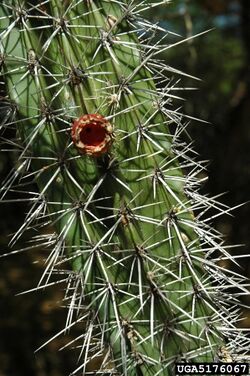Biology:Stenocereus griseus
| Stenocereus griseus | |
|---|---|

| |
| Stem and fruit of Stenocereus griseus | |
| Scientific classification | |
| Kingdom: | Plantae |
| Clade: | Tracheophytes |
| Clade: | Angiosperms |
| Clade: | Eudicots |
| Order: | Caryophyllales |
| Family: | Cactaceae |
| Subfamily: | Cactoideae |
| Genus: | Stenocereus |
| Species: | S. griseus
|
| Binomial name | |
| Stenocereus griseus (Haw.) Buxb.
| |
| Synonyms [1] | |
| |
Stenocereus griseus, also known as the Mexican organ pipe, dagger cactus, pitaya, and pitayo de mayo, is a species of cactus.[2]
Description

This tree-like cactus can grow up to 9 m tall, with stems up to 12 cm in diameter.[1] Depending on the cactus, the color of the fruit vary from white, yellow, red, and purple being the hardest to find.[citation needed]
Distribution
This species is found in Mexico in Oaxaca and Veracruz,[1] coastal Venezuela, Guajira Peninsula of Colombia and the ABC islands of the Dutch Caribbean.[3] It is found in scrub-lands.[4] Observations of this species have also been reported in the dry scrub-lands at the base of the Eastern Cordillera of the Colombian Andes. However it has not been collected in this region.[5]
Ecology
In the Caribbean islands of Aruba, Curaçao and Bonaire, this cactus blooms and fruits profusely during the dry season. It is a critical resource for bats, birds and other animals.[4]
Human uses
Its fruit is edible to humans and is considered good tasting. It is planted as an ornamental and as a living fence in warm regions.[4][6] When used as a fence, it can be impervious to animals due to its spiny nature.[6]
CITES status
The species is found in CITES Appendix II as a species of Least Concern. Its population is considered stable.[4]
References
- ↑ 1.0 1.1 1.2 Pitayo de Mayo (Stenocereus griseus)
- ↑ candle cactus, Stenocereus griseus (Caryophyllales: Cactaceae)
- ↑ Stenocereus griseus On-line Guide to the positive identification of Members of the Cactus Family
- ↑ 4.0 4.1 4.2 4.3 "Stenocereus griseus (Haw.) Buxb. - Encyclopedia of Life". https://eol.org/pages/5184499.
- ↑ "Neotropical Plant Portal - Stenocereus griseus". https://serv.biokic.asu.edu/neotrop/plantae/taxa/index.php?taxauthid=1&taxon=93921&clid=.
- ↑ 6.0 6.1 "Stenocereus griseus - Useful Tropical Plants". http://tropical.theferns.info/viewtropical.php?id=Stenocereus+griseus.
Wikidata ☰ Q288535 entry
 |

